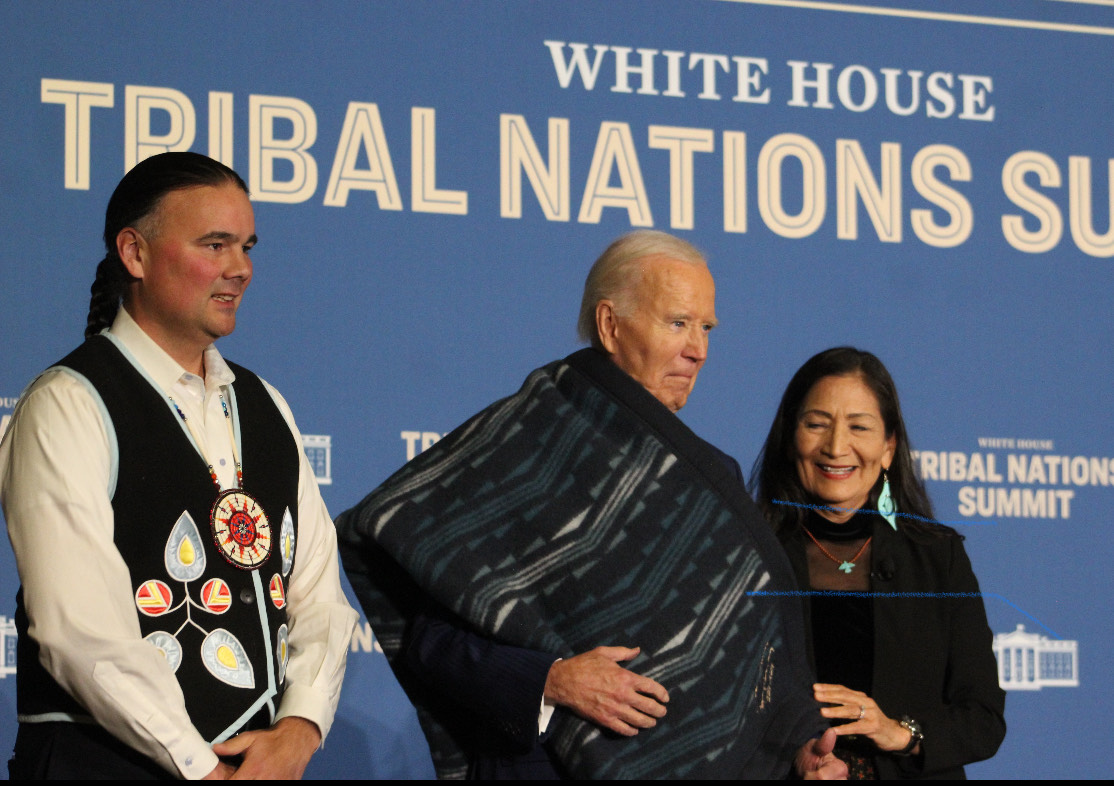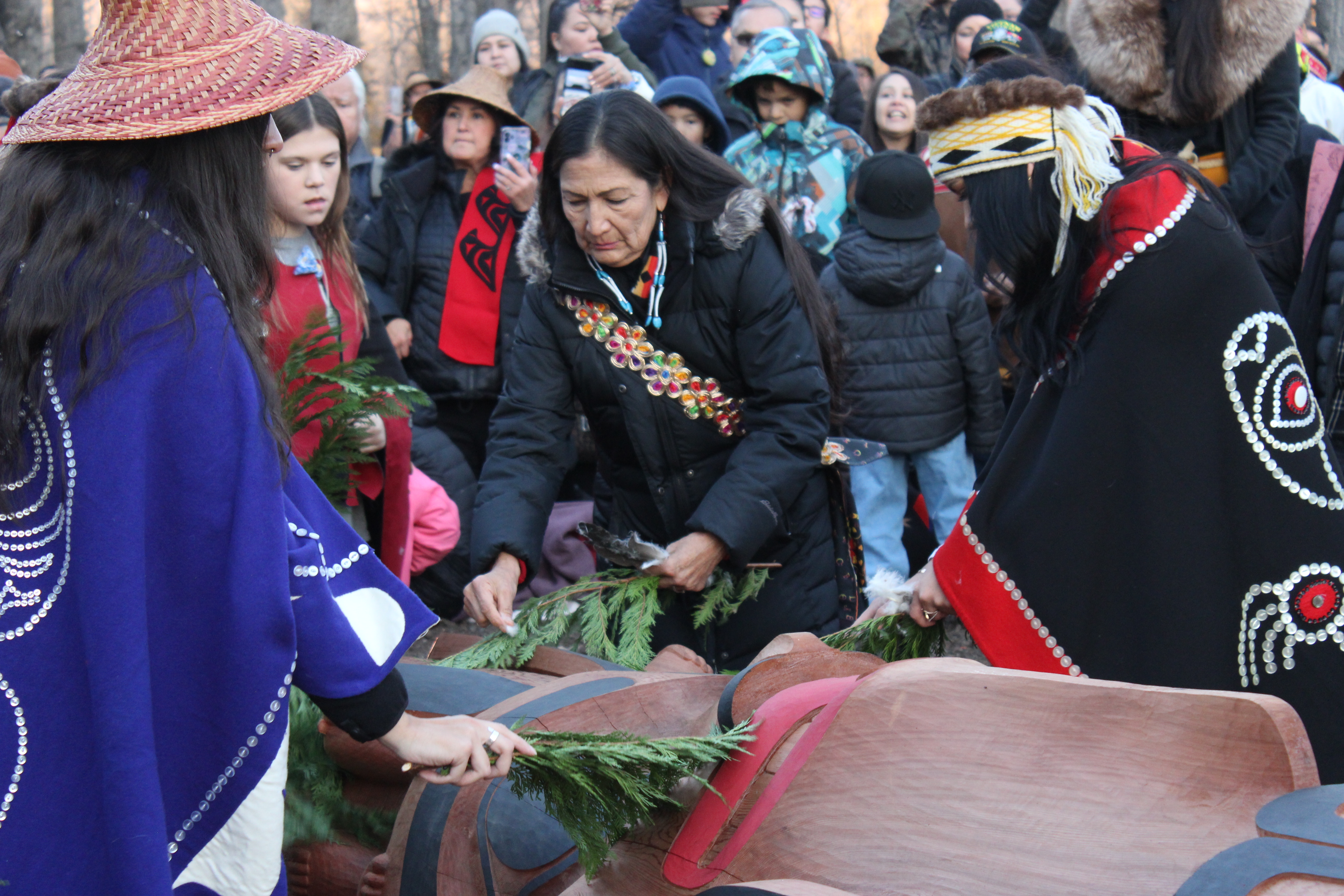
- Details
- By Levi Rickert
Opinion. In late October 2023, after the Road to Healing tour's stop at the Alaska Native Heritage Center in Anchorage, around 500 Alaska Natives gathered to witness the raising of a healing totem pole, created to honor those who attended Indian boarding schools.
Among the attendees were U.S. Department of the Interior Secretary Deb Haaland (Laguna Pueblo), Assistant Secretary Bryan Newland (Bay Mills Indian Community), and other Interior Department staff. Both Haaland and Newland participated in the totem-raising ceremony. Haaland, accompanied by a group of Alaska Native youth, placed cedar on the pole as a blessing, while Newland, braving the cold Alaskan October air, assisted in carrying the pole alongside a group of Alaska Native men.
 Make A Donation Here
Make A Donation Here
The totem pole, conceived as a symbol of healing, was envisioned by Haida elder Norma Jean Dunne (Haida/Tsimshian). It was carved at the Alaska Native Heritage Center by Haida master carvers Gidaawaan Joe Young and Sgwaayaans T.J. Young.

An inscription for the healing totem pole reads: “The healing totem depicts Bear mother who can be seen clutching her two cubs while the father (in human form) sits above her, embedded in a raven’s tail. Above him, the raven is mid-transformation, at a place in between a human and a raven form. Two children rest comfortably in raven’s ears.”
The raising of the healing totem pole was part of a deeply moving event that blended song, dance, and cultural ceremony. The totem was finally raised just before sundown, honoring the thousands of victims of Indian boarding schools. It stands as the only totem pole in the United States dedicated to those who endured the boarding school system.
The sight of so many people coming together to remember the victims was profoundly impactful. The ceremony was especially powerful because the painful history of physical, emotional, and sexual abuse suffered by Native students at these schools has left a lasting, traumatic legacy that continues to affect Native communities today.
After the totem was raised, I was driven to the airport for a red-eye flight back to Michigan. As I left Anchorage, I carried with me a renewed sense of hope. The totem pole stands as a powerful symbol that healing is possible for our tribal communities, who have endured so much suffering for so long.
After the completion of the Road to Healing tour, which consisted of 12 stops across various regions of Indian Country, in July 2024, the Interior Department released the Federal Indian Boarding School Initiative Investigative Report, Volume II that contains eight recommendations to help heal the aftermath of Indian boarding schools. One recommendation called for a national monument “to acknowledge and commemorate the experiences of Indian Tribes, individuals, and families within the Federal Indian boarding school system.”
Two weeks ago, at the 2024 White House Tribal Nations Summit, President Biden took another step in response to the findings of the investigative report by announcing the establishment of a national monument at the site of the Carlisle Federal Indian Boarding School.
The new monument will be located on 24.5 acres of what is now the U.S. Army's Carlisle Barracks, one of the country’s oldest military installations. The designated monument area will include the historic buildings and structures that once made up the Carlisle School campus, including the School Road Gateposts, which were constructed by Native American children and youth who were forced to labor at the school.
“About 7,800 children from more than 140 tribes were sent to Carlisle — stolen from their families, their tribes and their homelands. It was wrong making the Carlisle Indian school a national model,” Biden told the White House summit. “We don’t erase history. We acknowledge it, we learn from it and we remember so we never repeat it again.”
The president emphasized the significance of the new monument, which will stand as a reminder of the dark chapter in American history when Native Americans were forcibly taken from their homes and placed in Indian boarding schools. Many of these students endured physical, emotional, and sexual abuse.
This proclamation builds on President Biden’s historic apology at the Gila River Indian Community on October 25, 2024, further acknowledging the lasting harm caused by the boarding school system.
“Tens of thousands of Native children entered the system, nearly 1000 documented Native child deaths, though the real number is likely to be much, much higher,” Biden said at Gila River.”Lost generations, culture and language, lost trust. It's horribly, horribly wrong, it’s a sin on our soul.”
A national monument at Carlisle has the potential to play a vital role in the healing that is so urgently needed in Native communities. The progress made under the Biden-Harris administration toward addressing the legacy of Indian boarding schools must continue into the next administration.
Having witnessed the power of the healing totem pole in Anchorage, I believe a national monument at Carlisle will aid in this healing process and serve as a powerful reminder to both Native and non-Native Americans that we cannot erase history—especially this dark chapter of our nation's past.
Thayék gde nwéndëmen - We are all related.
More Stories Like This
Colorado cannot heal until it confronts Sand Creek honestlyNative American Mothers Deserve to Live
Technology Rooted in Tradition is Strengthening Cherokee Nation
The Lumbee Tribe of North Carolina: #575
Tribes Do Not Need a Greenlight to Build Renewable Energy
Help us defend tribal sovereignty.
At Native News Online, our mission is rooted in telling the stories that strengthen sovereignty and uplift Indigenous voices — not just at year’s end, but every single day.
Because of your generosity last year, we were able to keep our reporters on the ground in tribal communities, at national gatherings and in the halls of Congress — covering the issues that matter most to Indian Country: sovereignty, culture, education, health and economic opportunity.
That support sustained us through a tough year in 2025. Now, as we look to the year ahead, we need your help right now to ensure warrior journalism remains strong — reporting that defends tribal sovereignty, amplifies Native truth, and holds power accountable.
 The stakes couldn't be higher. Your support keeps Native voices heard, Native stories told and Native sovereignty defended.
The stakes couldn't be higher. Your support keeps Native voices heard, Native stories told and Native sovereignty defended.
Stand with Warrior Journalism today.
Levi Rickert (Potawatomi), Editor & Publisher

